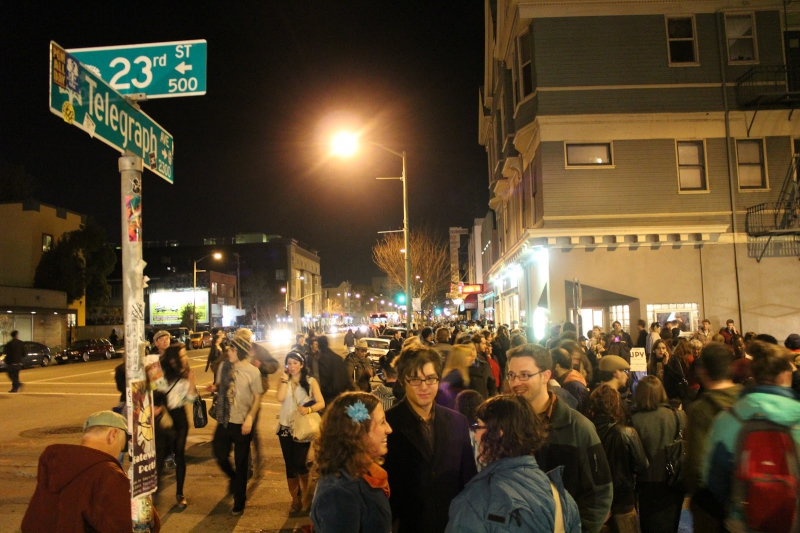Rock Beats Paper: On the Connections Between Art and Development
In a story that is all too familiar in the Bay Area, the owner of the building is raising the rent to market rate, which effectively triples the space’s current rent—far beyond the means of the artist collective. Considering the location, it is unsurprising that this would come to pass: Telegraph Ave. just north of Grand, heart of the redeveloped KONO corridor and on the edge of ever-trendy Uptown.
KONO, short for Koreatown-Northgate, is a name that was relatively recently stuck onto a stretch of Telegraph Ave from Grand Ave at the south, and on the north it goes vaguely to 27th, but slowly (or not so slowly) making its way further, in an attempt to connect it with the hip Temescal neighborhood. One of KONO’s primary projects has been the monthly First Friday art crawl turned street fair, attracting tens of thousands of people to the area to patronize the bars, restaurants and art galleries. First Fridays gained national acclaim in the New York Times a few years ago, as well as the transformations to the city it had brought with it. These transformations are celebrated by the RPS collective in their statement, RPS being one of the original initiators of First Friday. But what exactly has changed? Well, in Rock Paper Scissors’ own words:
“Oakland became a city known to foster creativity thanks to the work of so many collaborating individuals and groups. The Downtown, Uptown, and KONO districts became more attractive for tourists, restaurants and independent shops.”
In less flattering terms, the wealthy have been drawn towards these areas of Oakland in no small part due to the contributions of the artist community in making it a desirable, “hip” place to be, which is naturally followed by increasing property values, more extensive policing, a process otherwise known as gentrification. To claim RPS and the rest of the artist community accelerated and promoted gentrification might be more scandalous if not for their own admission:
“This space has become attractive to wealthier tenants BECAUSE of the years of hard work we have put in to building a community of engaged artists, musicians, and performers, and as a reward we are being kicked out to make way for a wealthier class of renters.”
Despite this clear-headed assessment, the collective refuses (intentionally or not) to fully grasp the connection between the creative culture they claim to build and foster, and the influx of capital that eventually pushed them out. In a once-desolate part of town, artists moved in and made it attractive to outsiders, paving the way for its eventual development. It would be naive to believe that we could have one without the other, and yet that is what their statement asserts. Your creative culture isn't being recuperated by capitalism, as some might suggest, it is simply a tool for capital to use: and after it's been used for years against others, now its being turned back on you. Now, RPS is looking into cheaper spaces, particularly in East Oakland, where they will continue to “foster creativity” and bring with them the capital that is never far behind. Perhaps in another ten years RPS will be moving again, this time to Richmond or Hayward. As some comrades in Hamilton put it recently, “You were the footsoldiers of gentrification—don’t say we didn’t warn you.”
This is not, however, a cry for the abandonment of creativity, as useless as the proliferation of blight is as a strategy against displacement. This is on one hand a plea, a desperate attempt to reconfigure the lens through which we view the connection between art and development in the Bay Area and the world over. On the other hand, this is a call for action, for confrontation with the forces of capital and white supremacy. Rock Paper Scissors claims to want to fight gentrification, according to a collective member quoted in a recent East Bay Express article on their closure: “A lot of people are just saying, ‘Well it’s gentrification.’ […] No. Thats not what you say. You fight this shit.” But this can only happen by a rethinking of what it means to be an artist, to be complicit in the development of creative capital, and how to sabotage that process. It is time to pick a side: are you interested in enriching the culture of the metropolis, or are you interested in destroying it?
For now, Rock Paper Scissors still resides on Telegraph Ave. And the only ones that will be able to physically remove them is the Alameda County Sheriffs Department, that has all the shortcomings of any material organization: a budget, higher priorities, limited numbers of available personnel, and a finite amount of potentially vulnerable technology to aid them in the process. Capitalist development is expanding at an alarming rate: any and all action that can be taken to sabotage the forces of domination (e.g. gentrification, white supremacy, capitalism, and more) should be taken.
On your mark get set, go!
Get Involved
If you'd like to help with maintaining or developing the website, contact us.
Publish
Publish your stories and upcoming events on Indybay.



